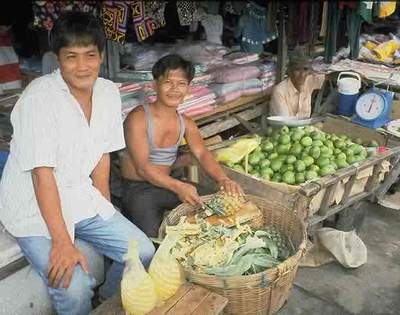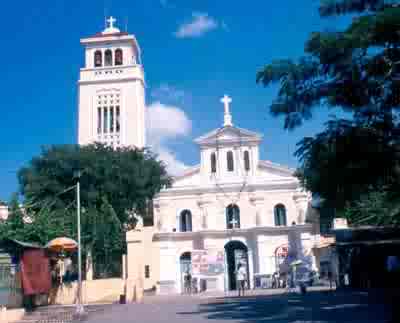Map of region where Manaoag is located
Manauag is a small town with the historic Manaoag Church in the province of Pangasinan. It is about five hours by bus from Manila. This rural area is known for very hot dry summers. The making of handicrafts, such as magazine racks, wine racks, baskets of various shapes and designs is a thriving and important industry that supplements the earnings of many low income farmers. The majority of the people in this area are tenant farmers whose plight has not improved because the land reform programs have failed. Common resources in the province include agricultural products such as rice, corn, and some vegetable varieties. Mango production is also an important industry. |
In manaoag the best way to get around is by jeepney
Jeepneys are the way most people travel. They are modified Jeep style vehicles carrying 16 to 18 passengers on benches facing each other in the back. One or two more passengers ride with the driver in front. Jeepneys have flags, decorations, colors, family names and nicknames, logos, mud flaps, and other ornaments. Most have altars on the dashboards. The shotgun seat is best and reserved for the disabled. You can travel across the city of manaoag for about 8 U.S. cents. It is the cheapest public transportation in the world, I understand.
|
The "Daily life" on local markets
 meeting people One of the possible locations to meet the people of the Philippines and to discover parts of the daily life of many Filipinos, is the market. The local markets in a big city or regional town are most of the time crowded and colorful. The sellers, young or older, will welcome foreigners in their stall. They are always prepared for a friendly talk, even if you don't buy. The Philippines is one of the developing countries where the sellers don't molest a foreigner in an attempt to sell. Most of the Filipinos speak English rather good, so, communication is not a problem.
Manaoag : "man-taoag"
When the missionaries arrived in Manaoag, the place was not yet called by its present name. The place was referred to as "Sapang". But an important religious even occurred as related by PP Baceta and Bravo in their joint work, Dictionario, and the Story of the Early Pangasinanes, which caused people from all parts of the province to come to Sapang on religious pilgrimages.So, almost all the people were called to the place as if duty-bound to perform and/or partake in religious obligations. The event, as related in the above named accounts, refers to the story of a man who was walking in a woody place above the Baloking Creek. It related that the man had heard a sweet voice, and as he turned his head toward the direction from which he had herd it, he saw the image of the Virgin and her Son on her left arm standing on the branch of a tall molave tree. The image appeared in rich and brilliant attire, and after long moments during which the man stood numb and speechless, the apparition disappeared. After this, other miraculous events occurred; word of these spread like wildfire among the nearby places, and then, in the entire province. Thus the name, "Manaoag" which is "man" meaning "to" prefixed to "taoag" meaning "to call" is given to the place where the apparition of the Virgin May occurred. # |

Manaoag church
The church of Manaoag is a sanctuary frequented by countless people from Pangasinan and from the neighboring provinces on account of the miraculous image of the Lady of the Rosary. This beautiful and solid image was made at the expense of Capitan d. Gaspar Gamboa, a tertiary of the Dominiean Order built in 1912. It measures 89 meters long and 13.65 meters wide. The cruciform built in 1932 is 53.50 meters long and 15.20 meters wide.
Send an email |


